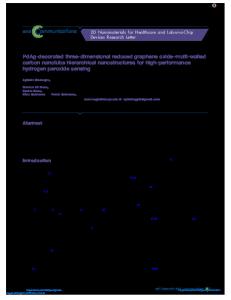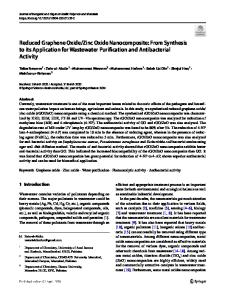Protein-Mediated Synthesis of Au Nanocluster Decorated Reduced Graphene Oxide: A Multifunctional Hybrid Nano-Bio Platfor
- PDF / 1,202,969 Bytes
- 7 Pages / 595.276 x 790.866 pts Page_size
- 7 Downloads / 392 Views
Protein-Mediated Synthesis of Au Nanocluster Decorated Reduced Graphene Oxide: A Multifunctional Hybrid Nano-Bio Platform Mark H. Griep 1
&
J. Derek Demaree 1 & Daniel P. Cole 1 & Todd C. Henry 1 & Shashi P. Karna 1
Received: 21 June 2019 / Accepted: 7 November 2019 # This is a U.S. government work and not under copyright protection in the U.S.; foreign copyright protection may apply 2020
Abstract The seamless integration of functional biomolecules with advanced nanomaterials not only allows for a hybrid material yielding their combined properties but also can enable novel joint functionality. In this work, the protein bovine serum albumin is used to simultaneously reduce and stabilize graphene oxide, demonstrating complete reduction of the graphene oxide to its reduced graphene oxide form. Where previous work has utilized a protein-reduced graphene oxide hybrid material as an attachment point for subsequent metal nanoparticle binding, this effort establishes an in situ methodology to directly synthesize tailored metal nanoclusters within the stabilizing protein complex. The successful synthesis of gold metal nanoclusters within the protein component of the hybrid system is verified, allowing for the creation of high-density protein-nanocluster ensembles on the graphene substrate. Utilizing the sensitive nature of the high-density protein-nanocluster materials, a protease sensor platform is demonstrated to detect the presence of trypsin, which is a biomarker for acute pancreatitis, at concentrations below 100 ng/mL. Keywords Graphene . Protein nanoclusters . Bio-nano hybrid . Protease sensor
Introduction Bio-mediated synthesis of nanostructures has attracted a great deal of attention in recent years [1] because of (i) the ease and environmentally friendly nature of the chemistry and (ii) an ever-growing list of potential applications, including antimicrobial agents [2], fluorescent bio-imaging [3], drug delivery agents [4], heavy metal sensors [5], and potential DNA contamination sensors [6]. Recent studies have also shown that bio-nano hybrid materials resulting from the bio-mediated synthesis of metal nanoclusters (NCs) retain the electronic/ optical properties of the metal clusters, while preserving the natural bioactivity of the biological molecules [6–8]. This additional feature makes the bio-mediated metal NCs a true multifunctional platform, extending its application space.
Electronic supplementary material The online version of this article (https://doi.org/10.1007/s11468-019-01082-w) contains supplementary material, which is available to authorized users. * Mark H. Griep [email protected] 1
WMRD, CCDC US Army Research Laboratory, Aberdeen Proving Ground, MD 21005, USA
Concurrently, there have also been rapid developments in synthesizing hybrid or composite nanomaterials composed of carbonaceous nanomaterials and metallic nanoparticles/nanoclusters [9–13] to realize materials with emergent photovoltaic, catalytic, electrochemical, magnetic, and electronic capabilities. Such advancements in t
Data Loading...











